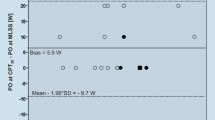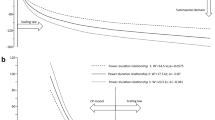Abstract
In maximal sprint cycling, the power–cadence relationship to assess the maximal power output (P max) and the corresponding optimal cadence (C opt) has been widely investigated in experimental studies. These studies have generally reported a quadratic power–cadence relationship passing through the origin. The aim of the present study was to evaluate an equivalent method to assess P max and C opt for endurance cycling. The two main hypotheses were: (1) in the range of cadences normally used by cyclists, the power–cadence relationship can be well fitted with a quadratic regression constrained to pass through the origin; (2) P max and C opt can be well estimated using this quadratic fit. We tested our hypothesis using a theoretical and an experimental approach. The power–cadence relationship simulated with the theoretical model was well fitted with a quadratic regression and the bias of the estimated P max and C opt was negligible (1.0 W and 0.6 rpm). In the experimental part, eight cyclists performed an incremental cycling test at 70, 80, 90, 100, and 110 rpm to yield power–cadence relationships at fixed blood lactate concentrations of 3, 3.5, and 4 mmol L−1. The determined power outputs were well fitted with quadratic regressions (R 2 = 0.94–0.96, residual standard deviation = 1.7%). The 95% confidence interval for assessing individual P max and C opt was ±4.4 W and ±2.9 rpm. These theoretical and experimental results suggest that P max, C opt, and the power–cadence relationship around C opt could be well estimated with the proposed method.







Similar content being viewed by others
References
Abbiss CR, Peiffer JJ, Laursen PB (2009) Optimal cadence selection during cycling. Int Sportmed J 10:1–15
Ansley L, Cangley P (2009) Determinants of optimal cadence during cycling. Eur J Sport Sci 9:61–85
Atkinson G, Davison R, Jeukendrup A, Passfield L (2003) Science and cycling: current knowledge and future directions for research. J Sports Sci 21:767–787
Bonjour J, Capelli C, Antonutto G, Calza S, Tam E, Linnarsson D, Ferretti G (2010) Determinants of oxygen consumption during exercise on cycle ergometer: the effects of gravity acceleration. Respir Physiol Neurobiol 171:128–134
Chavarren J, Calbet JA (1999) Cycling efficiency and pedalling frequency in road cyclists. Eur J Appl Physiol Occup Physiol 80:555–563
Delp SL, Loan JP, Hoy MG, Zajac FE, Topp EL, Rosen JM (1990) An interactive graphics-based model of the lower extremity to study orthopaedic surgical procedures. IEEE Trans Biomed Eng 37:757–767
Denadai BS, Ruas VD, Figueira TR (2006) Maximal lactate steady state concentration independent of pedal cadence in active individuals. Eur J Appl Physiol 96:477–480
Denoth J (2008) Theoretische Betrachtungen zur maximalen Leistung im Ausdauersport bei einem durch die maximale Sauerstoffaufnahme begrenzten Energieverbrauch. Sportmedizin und Sporttraumatologie 56:77–81
di Prampero PE (2003) Factors limiting maximal performance in humans. Eur J Appl Physiol 90:420–429
Dorel S, Hautier CA, Rambaud O, Rouffet D, Van Praagh E, Lacour JR, Bourdin M (2005) Torque and power–velocity relationships in cycling: relevance to track sprint performance in world-class cyclists. Int J Sports Med 26:739–746
Dorel S, Couturier A, Lacour JR, Vandewalle H, Hautier C, Hug F (2010) Force-velocity relationship in cycling revisited: benefit of two-dimensional pedal forces analysis. Med Sci Sports Exerc 42:1174–1183
Faria EW, Parker DL, Faria IE (2005a) The science of cycling: factors affecting performance—part 2. Sports Med 35:313–337
Faria EW, Parker DL, Faria IE (2005b) The science of cycling: physiology and training—part 1. Sports Med 35:285–312
Faude O, Kindermann W, Meyer T (2009) Lactate threshold concepts: how valid are they? Sports Med 39:469–490
Ferretti G, Bringard A, Perini R (2011) An analysis of performance in human locomotion. Eur J Appl Physiol 111:391–401
Foss O, Hallen J (2004) The most economical cadence increases with increasing workload. Eur J Appl Physiol 92:443–451
Francescato MP, Girardis M, di Prampero PE (1995) Oxygen cost of internal work during cycling. Eur J Appl Physiol Occup Physiol 72:51–57
Gardner AS, Martin JC, Martin DT, Barras M, Jenkins DG (2007) Maximal torque- and power-pedaling rate relationships for elite sprint cyclists in laboratory and field tests. Eur J Appl Physiol 101:287–292
Girardis M, Linnarsson D, Moia C, Pendergast DR, Ferretti G (1999) Oxygen cost of dynamic leg exercise on a cycle ergometer: effects of gravity acceleration. Acta Physiol Scand 166:239–246
Gruber K, Ruder H, Denoth J, Schneider K (1998) A comparative study of impact dynamics: wobbling mass model versus rigid body models. J Biomech 31:439–444
Hansen EA, Smith G (2009) Factors affecting cadence choice during submaximal cycling and cadence influence on performance. Int J Sports Physiol Perform 4:3–17
Hansen EA, Andersen JL, Nielsen JS, Sjogaard G (2002a) Muscle fibre type, efficiency, and mechanical optima affect freely chosen pedal rate during cycling. Acta Physiol Scand 176:185–194
Hansen EA, Jorgensen LV, Jensen K, Fregly BJ, Sjogaard G (2002b) Crank inertial load affects freely chosen pedal rate during cycling. J Biomech 35:277–285 Erratum in J Biomech 235:1521
Hansen EA, Jorgensen LV, Sjogaard G (2004) A physiological counterpoint to mechanistic estimates of “internal power” during cycling at different pedal rates. Eur J Appl Physiol 91:435–442
Hansen EA, Jensen K, Pedersen PK (2006) Performance following prolonged sub-maximal cycling at optimal versus freely chosen pedal rate. Eur J Appl Physiol 98:227–233
Hansen EA, Raastad T, Hallen J (2007) Strength training reduces freely chosen pedal rate during submaximal cycling. Eur J Appl Physiol 101:419–426
Harnish C, King D, Swensen T (2007) Effect of cycling position on oxygen uptake and preferred cadence in trained cyclists during hill climbing at various power outputs. Eur J Appl Physiol 99:387–391
Hausswirth C, Argentin S, Bieuzen F, Le Meur Y, Couturier A, Brisswalter J (2009) Endurance and strength training effects on physiological and muscular parameters during prolonged cycling. J Electromyogr Kinesiol. doi:10.1016/j.jelekin.2009.04.008
Henneman E, Olson CB (1965) Relations between structure and function in the design of skeletal muscles. J Neurophysiol 28:581–598
Hill AV (1938) The heat of shortening and the dynamic constants of muscle. Proc R Soc B 126:136–195
Hintzy F, Belli A, Grappe F, Rouillon JD (1999) Optimal pedalling velocity characteristics during maximal and submaximal cycling in humans. Eur J Appl Physiol Occup Physiol 79:426–432
Jeukendrup AE, Martin J (2001) Improving cycling performance: how should we spend our time and money. Sports Med 31:559–569
Kamon E, Metz KF, Pandolf KB (1973) Climbing and cycling with additional weights on the extremities. J Appl Physiol 35:367–370
Kautz SA, Neptune RR (2002) Biomechanical determinants of pedaling energetics: internal and external work are not independent. Exerc Sport Sci Rev 30:159–165
Kohler G, Boutellier U (2005) The generalized force-velocity relationship explains why the preferred pedaling rate of cyclists exceeds the most efficient one. Eur J Appl Physiol 94:188–195
Lajoie C, Laurencelle L, Trudeau F (2000) Physiological responses to cycling for 60 minutes at maximal lactate steady state. Can J Appl Physiol 25:250–261
Leirdal S, Ettema G (2009) Freely chosen pedal rate during free cycling on a roller and ergometer cycling. Eur J Appl Physiol 106:799–805
Lucia A, Hoyos J, Chicharro JL (2001) Preferred pedalling cadence in professional cycling. Med Sci Sports Exerc 33:1361–1366
MacIntosh BR, Fletcher JR (2011) The parabolic power–velocity relationship does apply to fatigued states. Eur J Appl Physiol 111:319–320
MacIntosh BR, Neptune RR, Horton JF (2000) Cadence, power, and muscle activation in cycle ergometry. Med Sci Sports Exerc 32:1281–1287
MacIntosh BR, Rishaug P, Svedahl K (2003) Assessment of peak power and short-term work capacity. Eur J Appl Physiol 88:572–579
MacIntosh BR, Svedahl K, Kim M (2004) Fatigue and optimal conditions for short-term work capacity. Eur J Appl Physiol 92:369–375
Marais G, Pelayo P (2003) Cadence and exercise: physiological and biomechanical determinants of optimal cadences: practical applications. Sports Biomech 2:103–132
Marsh AP, Martin PE (1995) The relationship between cadence and lower extremity EMG in cyclists and noncyclists. Med Sci Sports Exerc 27:217–225
Martin JC, Wagner BM, Coyle EF (1997) Inertial-load method determines maximal cycling power in a single exercise bout. Med Sci Sports Exerc 29:1505–1512
McNaughton LR, Roberts S, Bentley DJ (2006) The relationship among peak power output, lactate threshold, and short-distance cycling performance: effects of incremental exercise test design. J Strength Cond Res 20:157–161
Mendell LM, Henneman E (1971) Terminals of single Ia fibers: location, density, and distribution within a pool of 300 homonymous motoneurons. J Neurophysiol 34:171–187
Minetti AE (2011) Bioenergetics and biomechanics of cycling: the role of ‘internal work’. Eur J Appl Physiol 111:323–329
Minetti AE, Pinkerton J, Zamparo P (2001) From bipedalism to bicyclism: evolution in energetics and biomechanics of historic bicycles. Proc Biol Sci 268:1351–1360
Mora-Rodriguez R, Aguado-Jimenez R (2006) Performance at high pedaling cadences in well-trained cyclists. Med Sci Sports Exerc 38:953–957
Neptune RR, Kautz SA, Hull ML (1997) The effect of pedaling rate on coordination in cycling. J Biomech 30:1051–1058
Nielsen JS, Hansen EA, Sjogaard G (2004) Pedalling rate affects endurance performance during high-intensity cycling. Eur J Appl Physiol 92:114–120
Pfitzinger P, Freedson PS (1998) The reliability of lactate measurements during exercise. Int J Sports Med 19:349–357
Phillips CA, Petrofsky JS (1980) Velocity of contraction of skeletal-muscle as a function of activation and fiber composition—a mathematical-model. J Biomech 13:549–558
Prampero PED, Mognoni P, Saibene F (1979) Internal power in cycling. Experientia 35:925
Redfield R, Hull ML (1986) On the relation between joint moments and pedalling rates at constant power in bicycling. J Biomech 19:317–329
Sargeant AJ (1994) Human power output and muscle fatigue. Int J Sports Med 15:116–121
Sassi A, Rampinini E, Martin DT, Morelli A (2009) Effects of gradient and speed on freely chosen cadence: the key role of crank inertial load. J Biomech 42:171–177
Takaishi T, Yasuda Y, Ono T, Moritani T (1996) Optimal pedaling rate estimated from neuromuscular fatigue for cyclists. Med Sci Sports Exerc 28:1492–1497
Thomas V, Costes F, Chatagnon M, Pouilly JP, Busso T (2008) A comparison of lactate indices during ramp exercise using modelling techniques and conventional methods. J Sports Sci 26:1387–1395
Tokui M, Hirakoba K (2007) Effect of internal power on muscular efficiency during cycling exercise. Eur J Appl Physiol 101:565–570
Tokui M, Hirakoba K (2008) Estimation of oxygen cost of internal power during cycling exercise with changing pedal rate. J Physiol Anthropol 27:133–138
Vercruyssen F, Brisswalter J (2009) Which factors determine the freely chosen cadence during submaximal cycling? J Sci Med Sport. doi:10.1016/j.jsams.2008.12.631
Watson G, Swensen T (2006) Effects of altering pedal cadence on cycling time-trial performance. Int J Sports Med 27:296–300
Whitty AG, Murphy AJ, Coutts AJ, Watsford ML (2009) Factors associated with the selection of the freely chosen cadence in non-cyclists. Eur J Appl Physiol 106:705–712
Zelik KE, Kuo AD (2010) Human walking isn’t all hard work: evidence of soft tissue contributions to energy dissipation and return. J Exp Biol 213:4257–4264
Acknowledgments
These studies were supported by the Federal Council of Sports, Switzerland (ESK/BASPO). The authors are grateful for the participants’ cooperation in these studies.
Author information
Authors and Affiliations
Corresponding author
Additional information
Communicated by Guido Ferretti.
Rights and permissions
About this article
Cite this article
Emanuele, U., Denoth, J. Power–cadence relationship in endurance cycling. Eur J Appl Physiol 112, 365–375 (2012). https://doi.org/10.1007/s00421-011-1987-z
Received:
Accepted:
Published:
Issue Date:
DOI: https://doi.org/10.1007/s00421-011-1987-z




